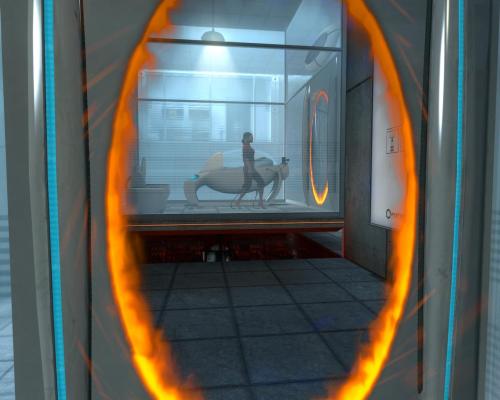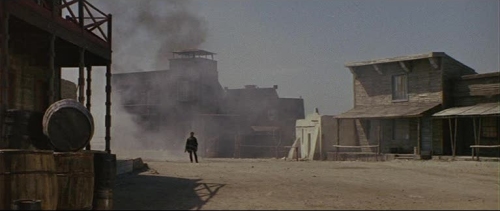
Few videogames had more words written about them during 2007 than Valve’s Portal. Not only was the game outstanding, but it had just the right amount of wit and oblique humour to make it go viral on the internet. How does the following sentence end? “The cake is a…”
It ends, of course, with me shoving a companion cube down your throat to keep you from ruining a perfectly funny game. So much has been uttered about Portal‘s successes and triumphs that it seems futile, irritating even, for me to try and add any more. There isn’t a lot that remains unsaid about Portal, and when the game’s creators have also said so much, I don’t have a lot to add to the conversation.
That being said, I do want to talk about Portal‘s game space. This is because Portal‘s game space is simply exceptional in the context of my continuing discussion of great game spaces. The portal gun might have been a great eye-catching mechanic, the GLaDOS humour might have been the internet-wildfire fuel, but it was the game space of Portal that was its real triumph. This is pure design through architecture. I used Portal as my primary text for my recent thesis, so a lot of the ideas here are cribbed directly from that document (which is forthcoming, I promise; results are in on the 12th and after that it’s free range).
Every inch of test chamber after test chamber in Portal is designed for a specific behavioural purpose. In an article for Gamasutra, Kim Swift, Jeep Barnett and Eric Wolwap say exactly what I was trying to say in my thesis clearer than I ever did:
Navigating the environment is Portal‘s primary gameplay challenge; In effect, the environment is your enemy.
That the player doesn’t notice this so obviously throughout their first playthrough of the game is telling. I suspect that the linear, puzzle based design of Portal was accepted by players more easily due to the test-chamber fiction of the game and place. In this sense, there is definitely a doubling between Portal‘s designers and GLaDOS. They perform similar functions: GLaDOS’ function is to test her subjects, and Valve’s function was to test their own labrats in order to predict and mould player responses. Playtesting was crucial for them, to the point where Walpaw and Swift claim that a single moment of confusion on the part of the player – any player – was their fault, and that “[they] failed you.”
This is almost entirely because the game space, coupled with a select few other factors, is designed to elicit a predictable response on the part of the player. For example, in one early room in the developer commentary (required listening; if you’ve played Portal and not taken the time to go back and play it again, you are missing one of the most illuminating gaming experiences you’ll ever have), Jason Brashill draws attention to what he calls “gates”. This is simply a strategy of putting a time-locked door between the player and the next area, which forces the player to take stock and process their options before charging ahead. This occurs at a number of points throughout Portal, and all work perfectly.
There are many similar examples of such focussed spatial design. In that memorable first room, the ‘relaxation vault’, Kim Swift notes:
It’s absolutely critical that players quickly wrap their heads around what a portal is. We noticed early playtesters grasped the concept much more quickly when they caught a glimpse of themselves through a portal, so we deliberately positioned this first portal to ensure that players will invariably see themselves.
Did you also know, for example, that the third test chamber is designed to teach you, the player, that the function of a portal is not tied to its colour? Apparently, during testing, there was a common misconception that, maybe, an orange portal could only be entered and not exited. Therefore, chamber three was created, and the space designed so the player may only complete it by entering and exiting the same portal. There are so many examples of this littered throughout Portal, from the design of the space in order to get players to look up, to the elimination of ‘incorrect’ solutions, to even the visual aesthetics cuing function. According to designer Paul Graham, “the [visual] design is essentially a balance between round objects and sharp objects; the sharp objects representing background elements, and the round objects [are points of interest like] doors and moveable props.”
This design even extends to creating emotion in the player. In the eleventh test chamber, players gain the fully powered portal gun. In order to build up anticipation for the moment of receiving this upgrade, two strategies are employed. First, as designer Lars Jensvold notes, the room is designed so that it brings players “in a circle around the device, so that it’s virtually always in sight” until the puzzle is solved and the portal gun is received. Secondly, once the puzzle has been solved, players may only access the upgraded gun via a slow-moving platform. The movement of the player is therefore limited to a slow, anticipation-building speed.
Clearly, Portal consciously organises environment through spatial strategies in order to influence player behaviour, emotion, and generally, experience and gameplay. Other games have done this many times over, but few have done it with such incredible focus and economy of design. Of course, as I’ve already admitted, few other games have had the benefit of placing you in such a ‘designed’ space as suspension-of-disbelief inducing test chambers, but there are surely many lessons to be learned from the level design here. Most importantly, Portal proves that it is almost possible to make a game work through sheer brilliance of level design and testing. It may well be the ten per cent of plot and other over-quoted aspects that made Portal the great game that everyone says it is, but it was the ninety per cent of spatial design that got it there to begin with. Portal might not embody many of the spatial qualities that I love (exploration and perspective to name just two), but it might just be my favourite game space ever designed.



